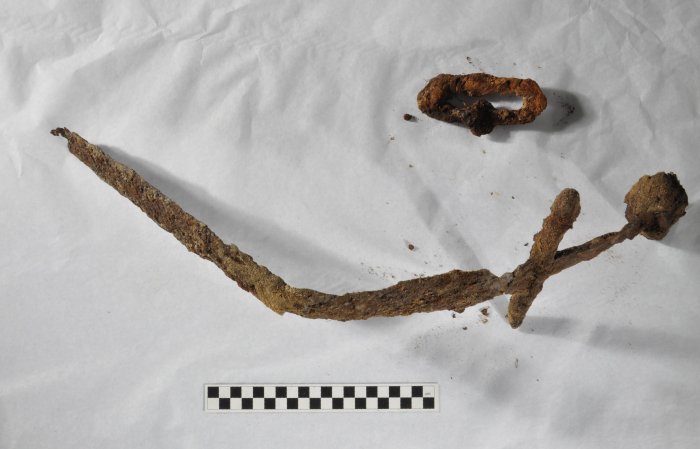Conny Waters - AncientPages.com - An interesting archaeological discovery has been made in Finland. In Salo Perttel, near the Medieval stone church, scientists have discovered a previously unknown burial site from the time of the Crusades.
The cemetery came to light during the archaeological inspection of a sword found in a geothermal pipe trench. This is the first definite discovery of a burial ground dating from the end of the Iron Age in the Salon or Uskelanjoki Valley.
Perttel's medieval stone church in Salonjokilaakso. The found Crusade-era mortuary is located in the yard of the house on the left. Photo credit: Juha Ruohonen / University of Turku, archaeology.
At the end of August, a local landowner noticed part of an iron object peeking out of the soil pile of a geothermal pipe trench in Salo Perttel. The object brought into view by the rains turned out to be an almost complete sword when taken out. The finder contacted Turku University's archeology teacher Juha Ruohose, who immediately reported the discovery to Sanna Saunaluoma, an archaeologist at the Turku Museum Center in charge of the Salo area. Saunaluoma visited the discovery site the next day.
"The sword is of the crusade era (ca. 1050–1150) type, with a bar-like, straight hilt, and a three-sided, plump oval pommel. The sword was delivered to the conservation unit of the museum center, from where it was transferred to the Museum Agency after X-rays", says Ruohonen in a press statement.
Since it was assumed that the sword was not a single loose find, Ruohonen did preliminary research with Turku University archeology students at the beginning of September to find out the nature of the discovery site. Blade parts belonging to the sword, human bones, possible coffin wood, and plenty of fragments of iron objects that have not yet been determined in more detail were found in the soil lifted from the trench.
A leather belt decorated with bronze bells can be considered the most remarkable collection of finds.
Crusader-era sword and part of the scabbard found in a geothermal pipe trench. Photo credit: Riikka Saarinen / Turku Museum Center.
"Thirty square bronze rings decorated with rosette patterns and several cross-shaped pendants have been attached to the belt. The set also included a buckle, several ends animal head buckles, and strap dividers. The leather parts of the belt are partially preserved. In addition, in connection with the bronze ornaments, there are plenty of fabric remnants related to the clothing of the deceased," Ruohonen describes.
One of the rosette-patterned bronze ornaments belonging to the Hela belt. Photo credir: Juha Ruohonen / University of Turku, archaeology.
All finds belong to one burial. The material found is interesting as a whole because archaeological textiles related to men's graves are very rare. Complete fire belts are also rare.
"A fire belt similar to the Pertteli find, but somewhat different in details, was excavated from Mikkola's grave III in Ylöjärvi in the 1950s. There is also a knife hanging from Perttel's belt, whose leather sheath decorated with bronze rings was also recovered," Ruohonen says.
The Discovery Is Part Of A Larger Cemetery
Archeological investigations also confirmed the existence of a mortuary cemetery larger than one grave. Eight dismembered graves were documented from the walls of the trench. The cemetery is extensive, and there are probably dozens, possibly even two hundred graves.
The grave pattern on the wall of the pipe trench. Photo credit: Juha Ruohonen / University of Turku, archaeology.
The observation can be considered very significant from a research point of view because cremation cemeteries from the time of the Crusades are clearly less known in Finland than cremation cemeteries that preceded them in time. So far, this is also the only confirmed burial burial dating to the end of the Iron Age from the Salon or Uskelanjoki valley. The deceased have been buried in the cemetery with Christian customs.
See also: More Archaeology News
"The location of the discovery site right next to a medieval stone church can be considered as evidence of a much earlier church organization in the area than previously estimated. The Pertteli parish has been considered the Uskela chapel founded in the 15th century," Ruohonen says.
Research on the found material will continue at least until the beginning of 2024. Radiocarbon dating of the found bone is being done, with which the period of use of the object can be made more precise.
Written by Conny Waters - AncientPages.com Staff Writer








